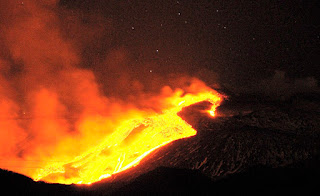Magma beneath the long-dormant Mount Edgecumbe volcano in southeast Alaska is moving up through the Earth's crust. According to this research, the Alaska Volcano Observatory was rapidly produced using a new method.
This new approach at the observatory could lead to early detection of volcanic unrest in Alaska.
Computer modeling based on satellite images shows magma at Mount Edgecumbe rising from about 12 miles deep to 6 miles deep. Caused earthquakes and significant surface deformation.
This is the fastest rate of volcanic deformation we currently have in Alaska, according to University of Alaska Fairbanks Geodesy Associate Professor Ronnie Grapenthin, lead author of the research paper, adding that while it is not uncommon for volcanoes to deform, the activity at Edgecumbe is unusual because reactivation of dormant volcanic systems is rarely observed. An eruption is said to be not imminent.
It was a first for the volcano team, which worked with the Alaska Volcano Observatory Alaska Satellite Facility, another Geophysical Institute unit, to process the data in the cloud.
Cloud computing uses remote servers to store data and provide computing services so the researcher does not need to download the data and sort it to process it, which can take weeks or months.
The research team began its work on April 11, 2022, immediately after detecting a cluster of earthquakes at Mount Edgecumbe. The researchers analyzed the previous 7 1/2 years of land deformation detected in satellite radar data.
We've done this type of analysis before, but new streamlined cloud-based workflows have reduced weeks or months of analysis to just days, said David Fee, coordinating scientist for the Alaska Volcano Observatory at the Geophysical Institute.

Mount Edgecumbe is 3,200 feet high on Kruzoff Island, west of Sitka Sound. It is part of the Mount Edgecumbe volcanic field which includes the adjacent crater ridge domes and crater.
The most interesting to researchers is centered on southern Kruzof Island, about 10.5 miles in diameter and 1.5 miles east of the volcano. Upward deformation began abruptly in August 2018 and continued at a rate of 3.4 inches per year until a total of 10.6 inches in early 2022.
Subsequent computer modeling suggested that the intrusion of new magma was the cause.
New deformation-based analysis allows early detection of volcanic unrest. Because ground deformation is one of its early indicators. Deformation may occur along with seismic activity. A key feature to look for is the raising of the earth.
While Mount Edgecumbe is not showing signs of an imminent eruption, this magma intrusion has been going on for three plus years now, before an eruption we expect more signs of unrest, more seismicity, more deformation, and especially changes in the patterns of seismicity and deformation, Grapenthin said.

According to the researchers, magma could have reached the upper chamber through a vertical conduit, but the thick magma already in the upper chamber prevented the magma from moving further upward, and new magma instead forced the entire surface up.
Mount Edgecumbe is about 15 miles west of Sitka. It has about 8,500 residents.
The volcano last erupted 8 to 9 hundred years ago. Presented by Herman Kitka in Tlingit Oral History. According to the account a group of Tlingits in four canoes camped on the coast about 15 or 20 miles south of some large smoke plumes. A scouting party in a boat was sent to investigate the smoke and reported a mountain glowing, flames and smoke belching.
Story Source:
Materials provided by University of Alaska Fairbanks. The original Rod Rod Boys.
Note: Content may be edited for attractiveness and length.
Know Scope of Geology
Visit Official Home Page






0 Comments